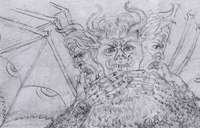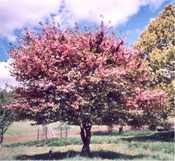 Today we recall the words Jesus spoke to Judas at the Last Supper, "The Son of man goes as it is written of him, but woe to that man by whom the Son of man is betrayed! It would have been better for that man if he had not been born." (Matthew 26:24). Judas has become is synonymous with the act of betrayal. In the Inferno, Dante places Judas in the very lowest circle of Hell, being devoured eternally by a three-faced, bat-winged devil:
Today we recall the words Jesus spoke to Judas at the Last Supper, "The Son of man goes as it is written of him, but woe to that man by whom the Son of man is betrayed! It would have been better for that man if he had not been born." (Matthew 26:24). Judas has become is synonymous with the act of betrayal. In the Inferno, Dante places Judas in the very lowest circle of Hell, being devoured eternally by a three-faced, bat-winged devil:
When we had gotten far enough along
that my master was pleased to let me see
the creature who was once so fair of face
he took a step aside, then brought me to a halt:
'Look there at Dis! And see the place
where you must arm yourself with fortitude.'
Then how faint and frozen I became,
reader, do not ask, for I do not write it,
since any words would fail to be enough.
It was not death, nor could one call it life.
Imagine, if you have the wit,
what I became, deprived of both.
The emperor of the woeful kingdom
rose from the ice below his breast,
and I in size am closer to a giant
than giants are when measured to his arms.
Judge, then, what the whole must be
that is proportional to such a part.
If he was fair as he is hideous now,
and raised his brow in scorn of his creator,
he is fit to be the source of every sorrow.
Oh, what a wonder it appeared to me
when I perceived three faces on his head.
The first, in front, was red in color.
Another two he had, each joined with this,
above the midpoint of each shoulder,
and all the three united at the crest.
The one on the right was a whitish yellow,
while the left-hand one was tinted like the people
living at the sources of the Nile.
 Beneath each face two mighty wings emerged,
Beneath each face two mighty wings emerged,
such as befit so vast a bird:
I never saw such massive sails at sea.
They were featherless and fashioned
like a bat's wings. When he flapped them,
he sent forth three separate winds,
the sources of the ice upon Cocytus.
Out of six eyes he wept and his three chins
dripped tears and drooled blood-red saliva.
With his teeth, just like a hackle
pounding flax, he champed a sinner
in each mouth, tormenting three at once.
For the one in front the gnawing was a trifle
to the clawing, for from time to time
his back was left with not a shred of skin.
'That soul up there who bears the greatest pain,'
said the master, 'is Judas Iscariot, who has
his head within and outside flails his legs.
'As for the other two, whose heads are dangling down,
Brutus is hanging from the swarthy snout --
see how he writhes and utters not a word! --
'and from the other, Cassius, so large of limb.
But night is rising in the sky. It is time
for us to leave, for we have seen it all.' (Canto XXXIV)
According to the pious legend, the tree upon which Judas hanged himself was the Cercis siliquastrum, also called the "Judas Tree." It is a beautiful tree, native to the Mediterranean region, which produces brilliant deep pink flowers in the spring; the flowers are said to have blushed in shame after Judas's suicide.



Leave a comment